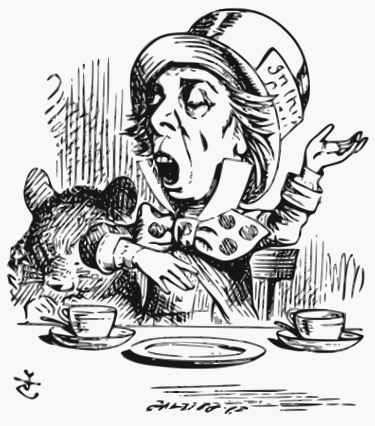
Hatters in the 18th and 19th centuries, used a toxic substance, mercury nitrate in the making of felted hats. Milliners are makers of ladies’ hats in particular, but hatters might have made felted hats for women as well as for men. Felt can be made from the fur or wool of many creatures and the mercury compound helped in the process by making the fibres more robust and easier to stick together by felting. Originally, felters had used camels’ urine for a similar purpose although as the trade grew further afield from camel lands, they substituted their own piss. Then a hatmaker who made particularly fine felt was discovered to have been taking mercury for the treatment of syphilis and the compound found its way into his work via his urine.
Hatters started to use mercury nitrate directly in their work – the compound is bright orange and the process became known as carrroting or secretage, perhaps because it was a trade secret. At this stage, the mercury nitrate was not so harmful, but once the felting has produced a fabric, it must be shaped to a mould of the hat shape with steaming and more rubbing (felting). The fumes were very poisonous and hatters developed tremors and other symptoms of mercury poisoning. It is for this reason that mercury barometers are banned in case firemen should inhale the fumes during a fire. Eventually, the process was outlawed and Mad Hatters became a thing of the past, of perhaps the most colourful and well-known forms of occupational hazard.
One of the most famous Mad Hatters, is the one who appears in Lewis Carrol’s “Alice in Wonderland” under the name of “Hatta”, and having grown up in Oxford, where Charles Dodgson had written as Lewis Carrol, and with Tenniel’s amazing illustrations, the hatter was imprinted on my brain from an early age…

A more recent and equally tragic incidence of mercury poisoning is depicted in the film “Minamata” in which Johnny Depp plays a “Life Magazine photo journalist, Eugene Smith, persuaded to photograph the victims of the disease as a result of a nearby factory polluting the sea and poisoning the fish eaten by the local people. The terrible contortions to affected bodies go far beyond the madness of hatters, a moving watch…

The languages from the Wikipedia article on Cant, are today:-
Camel urine and Mercury and a technique called Carroting… Learning something new every day! Not sure how I feel about felt right now 😉
There are worse things Tamara – French Polish (as on posh furniture) is made from the boiled up bodies and droppings of the Lac Fly… Lol
OMG (and I hope you know what that one means). Your comment was more disturbing than the post. LOL!
Donna McNicol – My A to Z Blogs
DB McNicol – Small Delights, Simple Pleasures, and Significant Memories
My Snap Memories – My Life in Black & White
Yes, I am afraid that French-Polish (Shellac) is definitely not vegan… hope you weren’t eating breakfast at such a table…
Urine has had its place in many procedures, Harris tweed being a notable one.
Leather making too I think – I wonder if they use synthetic urea now – after all, it was/is a major ingredient in some plastics…